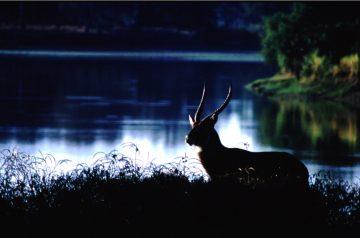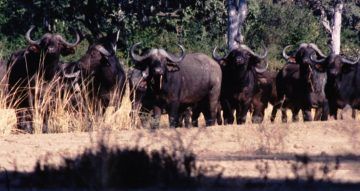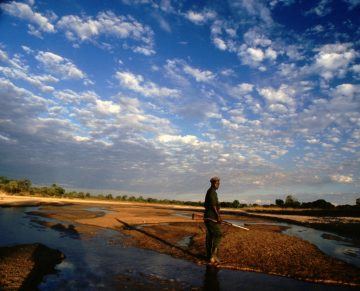by Bill Murray
 Late morning heat rises in waves over tall grass. It’s an hour and a half drive, sand flies buzzing, to Luwi bush camp, a seasonal camp with just four huts of thatch and grass on a still lagoon, far out into Zambia’s South Luangwa National Park, about 300 miles north of Lusaka.
Late morning heat rises in waves over tall grass. It’s an hour and a half drive, sand flies buzzing, to Luwi bush camp, a seasonal camp with just four huts of thatch and grass on a still lagoon, far out into Zambia’s South Luangwa National Park, about 300 miles north of Lusaka.
Perched on a cliff above the Luwi River, today the little camp is empty, but for the permanent staff of six – permanent, that is, for the five months each year camp is open. When the rains come in November they tear down Luwi camp and in late April a work crew of twenty rebuilds it top to bottom in order to have it open by June first. We’re first in, a little early at the end of May.
No other guests, just the staff, our guide Aubrey and a European named Grete, who will manage Luwi camp this season. Six months a year Grete is a translator in Brussels (English, French, Dutch and Spanish) and she spends the other six in the bush. Aubrey has a literate streak himself, framing sentences conditionally, starting like “Whereas, with the puku….”
•••••
There’s a chill before dawn. We dress hurriedly in the dark and huddle close-in around a coffee pot over the mopane campfire kept burning since sunset. Our party musters under a creeping orange sky as the bush fills with whistled, warbled, clucked and chattered birdsong declarations that yes, I’ve made it another night; my territory remains mine, so you just stay away.
 This morning, a walking safari. My wife Mirja and I will walk behind a rifle-toting scout and Aubrey, the four of us trailed by a young apprentice carrying coffee and biscuits, the “tea boy.” Isaac, a stoic, leathery bush veteran with a beret and a .357 caliber Brno rifle, will scout.
This morning, a walking safari. My wife Mirja and I will walk behind a rifle-toting scout and Aubrey, the four of us trailed by a young apprentice carrying coffee and biscuits, the “tea boy.” Isaac, a stoic, leathery bush veteran with a beret and a .357 caliber Brno rifle, will scout.
The grass between camp and the river is taller than we are. At the riverbank Isaac and Aubrey part it, revealing crocodiles on the opposite bank. Standing in the shadows, before the sun, on a rise just above the water’s edge, I cannot think why crocs would only inhabit the far bank. Watch your feet.
In these first few minutes Aubrey has already explained the three territorial zones of animals: the zone of awareness, the warning zone and the zone in which instinct takes over and the animal attacks. We don’t think we’re in anybody’s zone, but step gingerly onto a ledge a dozen meters above the river, and sit on a log to watch the sun establish sovereignty.
Water lettuce covers the lagoon. A pod of hippos stands noses just out of the water. The river stretches into a long, slow bend to the right, the near shore sandy cliffs. There is another hippo pod a few hundred meters beyond, just before the bend. Nature blossoms with sound. Nothing manmade is here to be heard or seen.
Below the bend on the opposite bank, Guinea fowl go grubbing the soil, the blue of their helmets indistinct in early light. A hippo breaches the brush, late getting back home, and scatters them.
Hippos don’t eat fish. They graze outside the water after dark, eating around 40 kilos a night. Which takes a lot of grazing. This one pauses at the water’s edge, jerks up his head, snarls, snaps ineffectually, and plunges into the river.
“He is having a bad time with the oxpeckers,” Aubrey explains. Oxpeckers are opportunists. In Ngorongoro Crater, in Tanzania, these birds ride on giraffes’ backs and get a nice aerial view. Here in Zambia, these local oxpeckers have water taxis.
The pod rests, still as autumn leaves the day before they fall. Only their heads and backs are visible, the rest of them covered with water lettuce.
 If this were a painting you’d scoff. Too elaborate to be real. But it is real, and we stay for long moments until the morning shadows have crossed the river and sunlight reigns.
If this were a painting you’d scoff. Too elaborate to be real. But it is real, and we stay for long moments until the morning shadows have crossed the river and sunlight reigns.
Rains from November to April flood the Luangwa watershed, then April until November are perfectly dry. Rivers and streams recede, forcing the animals into greater and greater concentrations, resulting in increased conflict and danger from predators.
For now in May, there is peace. Crocodiles eat catfish in the lagoon. The grass is green and tall and thick. Hippos gorge in the fields and live in the river.
Aubrey shows the way hippos change the landscape as they come and go from the river, creating indentations on the water’s edge that grow when it rains, collapsing the soil into gullies and washing it into the river. Other animals use and widen the trampled paths, which extend far up onto land. Eventually hippo trails may even evolve into rivers.
We set out away from the river on a sandy-bottomed hippo trail a meter wide, the grass on either side too tall for us to see ahead or to either side. Isaac guides us toward a stand of mopane trees.
 It’s one thing from a safari vehicle, but holding the attention of a hundred buffalo is an entirely different experience when all that’s between you and the herd is grass. They get our scent and turn with the precision of a murmuration of starlings, presenting a rather more solid wall, impenetrably long. They form up and stare intently. Aubrey’s “zone of awareness.” One steps forward and sniffs for the group.
It’s one thing from a safari vehicle, but holding the attention of a hundred buffalo is an entirely different experience when all that’s between you and the herd is grass. They get our scent and turn with the precision of a murmuration of starlings, presenting a rather more solid wall, impenetrably long. They form up and stare intently. Aubrey’s “zone of awareness.” One steps forward and sniffs for the group.
•••••
The sand beneath our feet is a treasure of information. Just now, it holds hyena and leopard prints. Aubrey and Isaac study them and judge they’re from last night or earlier this morning, because they’re still largely undisturbed. If one had overlapped the other, we could judge whether the leopard followed the hyena or, more likely the opposite.
Aubrey brings us to the trunk of a tree to examine puku fur, very soft, and explains that this puku fell victim to a leopard. We know that leopards take the fur off, he says, and this fur is clearly not digested. And, under a mopane with its strong, nearly horizontal branches is a good place for a leopard to take a meal, since at any danger he can hoist his kill up and away into the tree.
We are walking through grass mostly over our heads, with little wildlife, but the spoor puts on quite a show. From Dutch through Afrikaans, spoor means ‘track’ in two senses – first, the scent or track an animal leaves, and second, railroad tracks (A map of the Dutch rail network is a spoorkaart).
Aubrey categorizes spoor for tracking wildlife: aerial spoor, like branches or grass pushed back by passing game, ground spoor, like footprints and sign, and other evidence like droppings or dislodged stones or the water lettuce we see far from the river, which has been carried up on hippos’ backs.
 Isaac and his .357 Brno lead us down into the riverbed itself, where there is more than a month of footprint history since the last time it rained: elephant prints with lion prints inside, hippos, every bird and no humans tracks except ours since the end of the rains.
Isaac and his .357 Brno lead us down into the riverbed itself, where there is more than a month of footprint history since the last time it rained: elephant prints with lion prints inside, hippos, every bird and no humans tracks except ours since the end of the rains.
Here is a lion kill. We know this because of the remnants of the victim. Unlike the leopard, lions eat the whole unfortunate animal, and in this dung are fur and bone fragments.
Isaac stares ahead all the time as if something is always about to happen. He scans above the grass with field glasses.
He’s retired from the park service and keen to pass on the oral tradition to the guides and tea boys. He’s strong on the medicinal uses of plants, from increasing lactation to ameliorating skin disorders to preventing miscarriage.
The grass gives way to trees, larger the farther from the river. A particular bird flaps and cries and flies out in front of us. Aubrey says it’s trying to lead us to a bees’ nest, because if we disturb the nest we will help it eat them. (Almost like honeyguides, birds that collaborate with humans to find honey in Mozambique.)
Egyptian geese (Aubrey says) fly over as we sit at a not quite entirely dry lagoon. Aubrey hands around coffee and crouches alongside. Already it’s hot. I reach into my camera bag and I’m horrified to brush against a furry, live thing in there, one very large arachnid. Aubrey laughs and gently picks him up by a leg and puts him on the ground in front of us.
It’s a baboon spider, he says, a type of tarantula. It’s hairy, several inches across and I wonder how long I’ve been carrying it around. Frightening damned things, they are big and robust enough to loosen soil and excavate burrows with their jaws and fangs.
This fellow’s North and South American cousins have barbed hairs on their abdomens which they can fire defensively like porcupines with their quills. It seems these hairs deter would be attackers by irritating their noses. The African variant does not have that capability. It is more likely that inquisitors, like my big fat fingers in my camera bag, will just get bit.
I shudder; Aubrey offers consolation: Another tarantula species called the Goliath Birdeater weighs in at five ounces, with a leg span of twelve inches.
A different kind of spider has built a funnel-shaped web in a tree trunk with what Aubrey calls “telephone lines” extending upward from it to the side of the trunk. Aubrey explains how the spider lives safely below and can tell by the vibration of his phone lines when something flies into his funnel. He is thus called up to dinner.
•••••
At first measure, Luwi bush camp was rustic, but after walking in the tall grass over leopard and hyena tracks, hiking along a river where crocs sunned on the opposite bank, and sharing coffee with a stowaway spider, it’s remarkable how lovely Luwi camp looks now, with its thatch cottages and en suite facilities, its pot of coffee and wildlife magazines.
They’ve put on omelettes and sausages. Mirja retires to a hammock to read Surviving in the African Wild while I sit in chairs arrayed around the campfire, moving from one to the next to stay in shade, and we listen to the hippos in the river and the wild array of birds.
The grass in front of camp extends several hundred meters to the riverbank, and heat shimmers at midday. Waterbucks wander in twos and threes. Tiny cumulus clouds daub at the horizon under cerulean sky. Alone in camp we sprawl out careless, camera here, camera bag there, a pile of Wildlife and Africa Birds and Birding magazines over there.
Later, high broken clouds provide escape from the full sun. Now, in May, Aubrey thinks these look like October skies, in the month before the rains. The dry season doesn’t yet hold full sway.
The night sky is simply magnificent. We find south with the Southern Cross. The Big Dipper is upside down, low in the northern sky. The lantern casts unsure light under a splayed out Milky Way.
Aubrey grows melancholy by the fire. Where once he had three sisters and three brothers, now he’s the head of the family. He has one sister, and matter-of-factly explains the others died of “natural causes.”
Motionless, he stares into the fire and into his past, and turns to us. His mother’s brother was ill south of Lusaka. She went to care for him. While she was gone, one of her sons, younger than Aubrey, took ill. They sent word and she boarded a bus home.
A few kilometers south of Chipata, the nearest proper town, the bus blew a tire and his mother was killed. Aubrey’s father was already ill, so Aubrey went to get the body and they buried her the next day. His father lost the will to live, Aubrey says, and died four months later.
“This is African life.”
HIV? He just shakes his head. He has grown concave with gloom.
The price of maize skyrocketed between the end of last year’s store and this year’s harvest. Aubrey tells two horrifying stories he has heard about maize and making ends meet:
A farmer protecting crops surprises a thief carrying a stolen bag of maize. The thief decapitates the farmer and leaves the bag, head inside, on the farmer’s porch for his wife to find. She opens the bag, unsuspecting.
A father is taking his son to the doctor but his son dies en route. The man rolls his son up in cloth and begins the sad return to his village, but has car trouble. A farmer finds the bundle where the car is broken down, suspects theft of his maize, flies into a rage and kills the bereaved father.
Aubrey looks tired. This is all heartbreak and woe.
He tells another story, though, and gradually brightens. It’s hard to understand it all, but in outline, in Zambian folk practice a prospective groom’s uncle on his mother’s side goes to his desired bride’s family to negotiate a bride price – cows, for example, or maybe even simply that they can visit their daughter as often as they want. Once the bride price is settled, an elaborate ritual takes place to get her to the wedding bed.
The groom-to-be arrives alone at the young girl’s village and the mother of the bride leads him to their house. It starts with the young man inside alone. The young girl’s mother brings her to the house. She won’t come in. There is cajoling. Now the door is open. He throws coins; She steps closer.
In the end they spend the night and don’t come out until the next day, and the next day they are married. It’s a festive day with food offerings from both sides of family, and the dowry is delivered. A log is set alight to burn for one month, and during that month a couple must conceive.
The catch is, if the bride isn’t pregnant by the time that log goes out, in a month, the bride’s family can give the boy back. “I am fighting that log,” he smiles. Aubrey is a newlywed.
•••••
Lions call out in the predawn while everybody gathers around the pot of coffee. Tropical boubou shrikes sing in duet, so much at the same instant that you think it’s one, with a curious detail at the end of the call that sounds like a cross between a snare drum and plucking a guitar string.
Aubrey’s spirits are bright again. He wants to know about where we live and when he learns Mirja is from Finland he’s apologetic, but he can’t understand how anyone can live where it’s cold.
“The coldest I’ve ever been is at Bangola. It’s over the escarpment,” he says.
The mist was so thick you couldn’t see ten meters, he marvels. He does allow, though, that he’d really like to see snow before he dies and I offer that he might consider Table Mountain in Cape Town. But for Aubrey, South Africa might as well be the moon.

